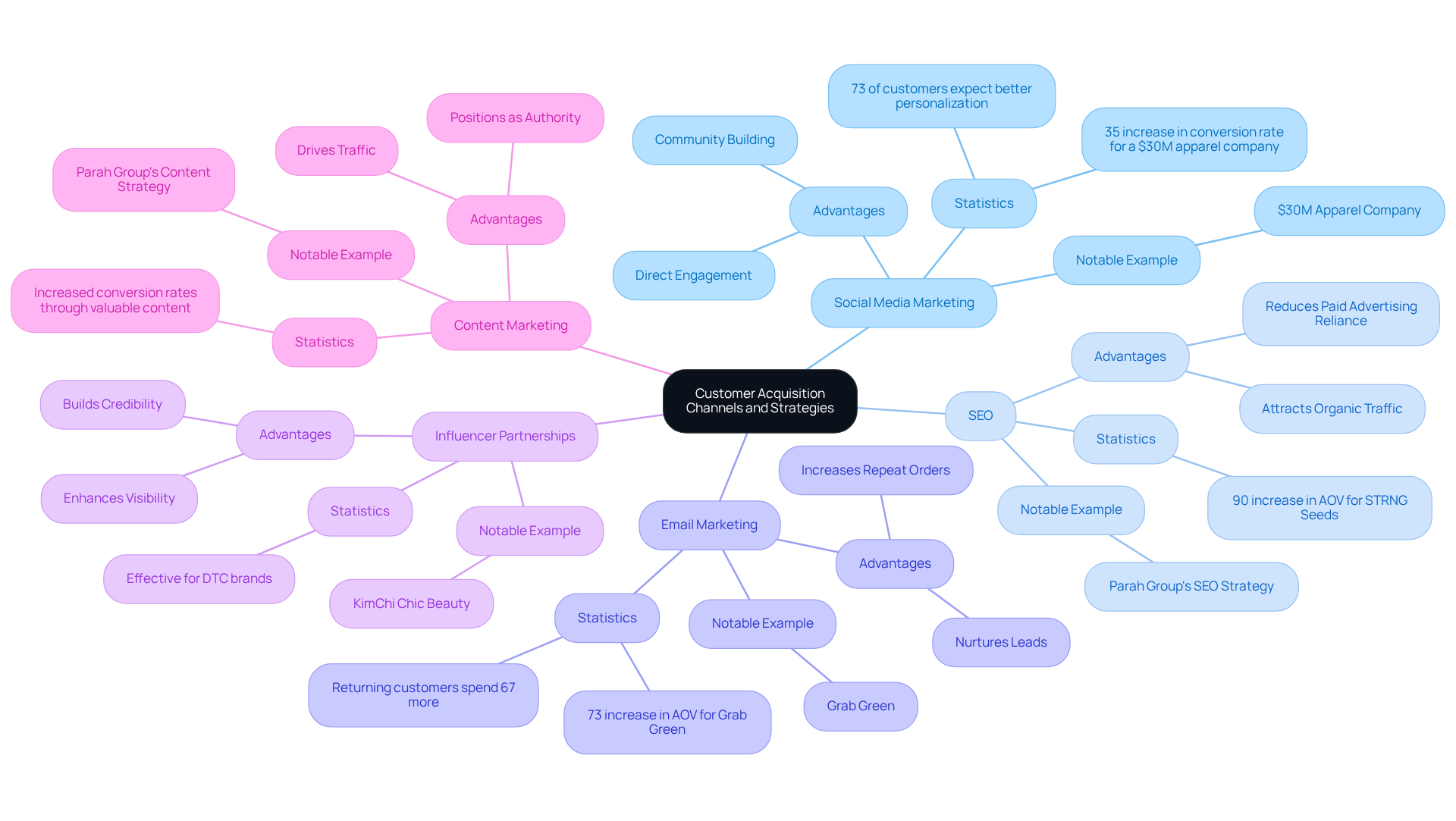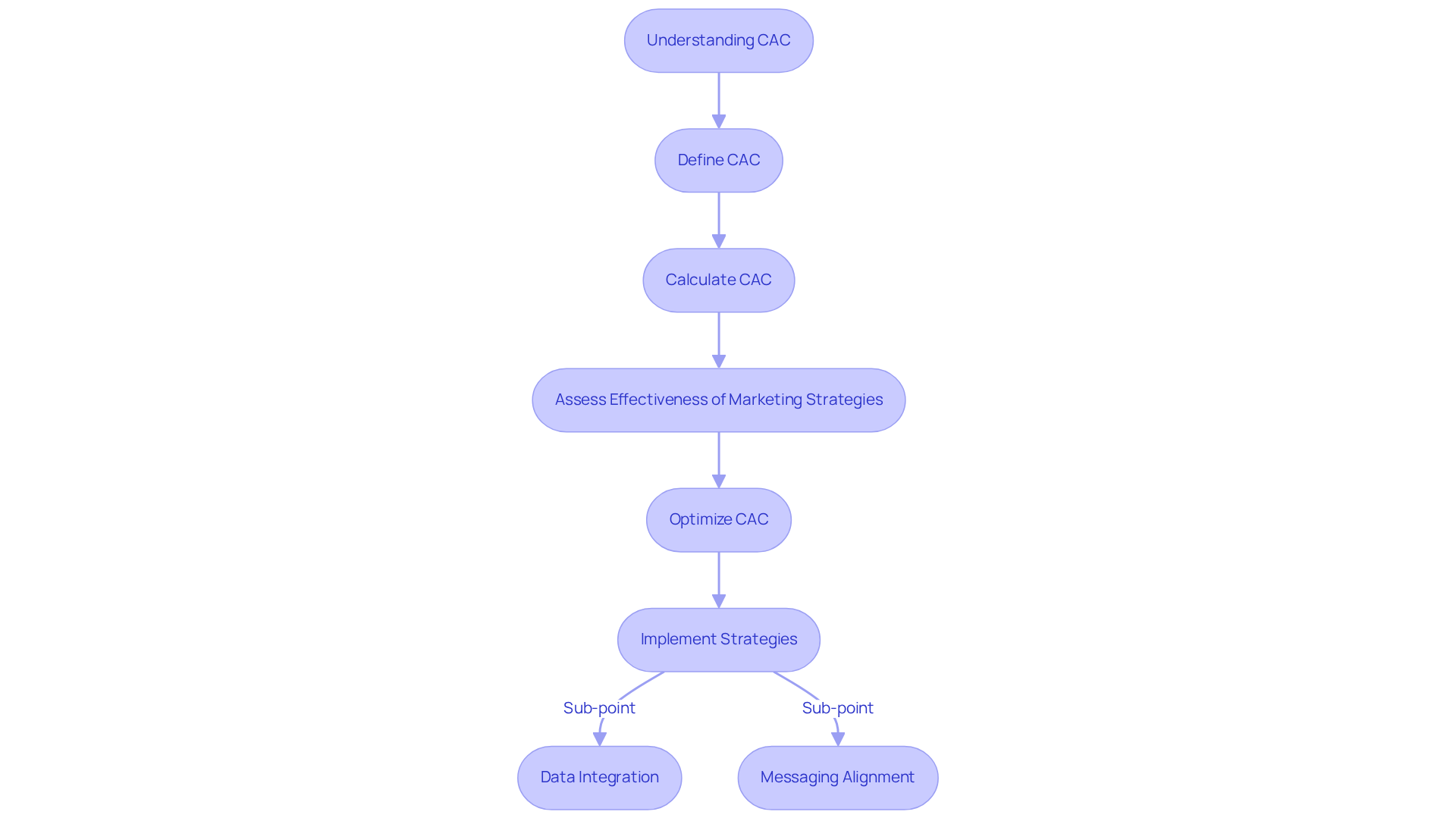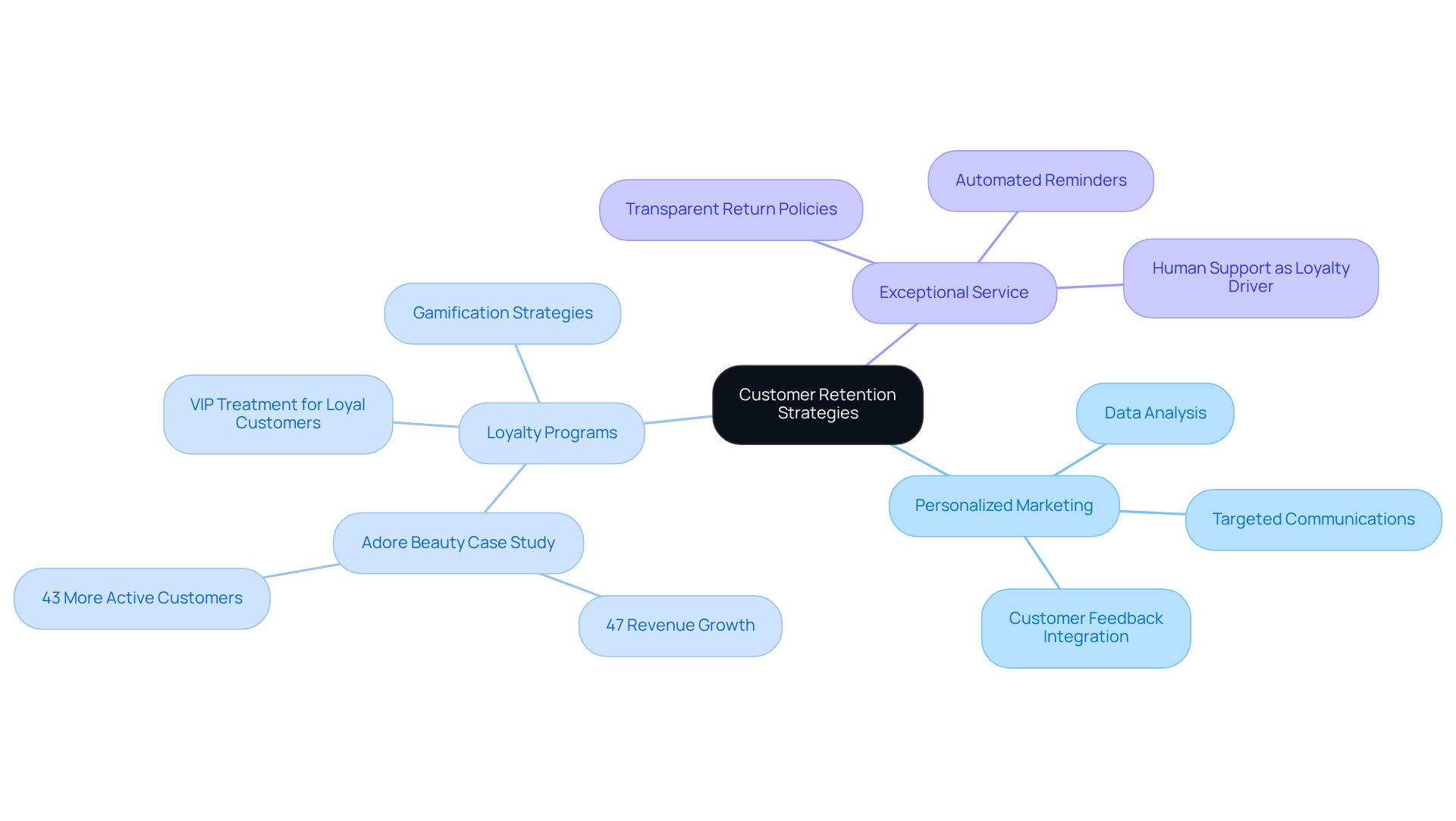
Overview
Customer acquisition for direct-to-consumer (DTC) brands is a critical process that transforms potential clients into actual purchasers, serving as a cornerstone for revenue growth and market presence.
Understanding customer acquisition costs (CAC) is essential; it allows brands to manage expenses effectively while fostering sustainable growth in a competitive landscape.
Employing strategies such as:
- social media marketing
- SEO
- influencer partnerships
is not merely advantageous but imperative for DTC brands aiming to thrive. These tactics not only enhance visibility but also drive engagement, ultimately leading to increased sales.
To navigate the complexities of customer acquisition, brands must prioritize strategic investments that yield measurable returns, ensuring long-term success in an ever-evolving market.
Introduction
Understanding customer acquisition is essential for direct-to-consumer (DTC) brands aiming to excel in a competitive landscape. As these companies confront escalating costs and evolving consumer behaviors, the capacity to effectively convert potential clients into loyal customers becomes critical. This article examines the multifaceted nature of customer acquisition, investigating strategies that not only boost initial engagement but also emphasize retention—an often underestimated yet crucial aspect of sustainable growth.
How can DTC brands navigate the challenges of high acquisition costs while fostering a dedicated customer base?
Define Customer Acquisition and Its Importance for DTC Brands
Client engagement is a pivotal process that illustrates customer acquisition meaning by transforming potential clients into actual purchasers of a company's products or services. For direct-to-consumer (DTC) companies, effective client onboarding is not just beneficial; it is essential, as it directly influences revenue expansion and market visibility. In an increasingly competitive landscape, where client onboarding expenses (CAC) are on the rise, understanding the intricacies of this process becomes paramount. DTC brands must focus not only on customer acquisition meaning but also on retaining clients, as the cost of acquiring a new client is often significantly higher than that of keeping an existing one. This dual focus on customer acquisition meaning and retention is the cornerstone of sustainable growth and profitability in the DTC sector.
Effective client engagement strategies frequently incorporate innovative approaches such as affiliate marketing, which can account for 20-30% of overall revenue while incurring a fraction of the CAC associated with paid social techniques. This performance-driven model allows companies to compensate partners only after a sale or lead is generated, thereby aligning expenses directly with revenue outcomes. As industry experts have noted, "the era of growth-at-all-costs for direct-to-consumer brands is over, with rising client expenses (CAC) and diminishing return on advertising investment (ROAS)," necessitating a reevaluation of outreach strategies. Moreover, many firms are now investing five to six figures monthly in Meta ads, often achieving sub-1.5x ROAS, which highlights the financial pressures these companies face.
In this dynamic environment, DTC companies that adopt robust client engagement strategies not only bolster their market presence but also catalyze substantial revenue growth, ensuring competitiveness amid escalating CAC and shifting consumer behaviors. Additionally, channel diversification is crucial for DTC firms to mitigate risks associated with over-reliance on singular sourcing channels.

Explore Customer Acquisition Channels and Strategies
DTC companies can efficiently connect with their target demographic by utilizing a range of acquisition channels and strategies. Key channels include social media marketing, search engine optimization (SEO), email marketing, influencer partnerships, and content marketing, each offering distinct advantages.
-
Social Media Marketing: Platforms like Instagram and Facebook enable brands to engage directly with consumers, showcase products, and foster community connections. With 73% of customers anticipating improved personalization, companies that utilize social media effectively can enhance customer loyalty and drive organic marketing through community advocacy. A notable example is a $30M apparel company that improved its conversion rate by 35% through strategic homepage redesigns that highlighted social proof and reviews.
-
SEO: Optimizing website content for search engines attracts organic traffic, reducing reliance on paid advertising. This approach is crucial as digital ad rates have escalated significantly, making organic visibility increasingly valuable. Parah Group's approach to SEO has helped brands like STRNG Seeds achieve a 90% increase in average order value (AOV) by enhancing site usability and implementing targeted landing pages.
-
Email Marketing: Personalized email campaigns nurture leads and convert them into buyers by delivering tailored offers and relevant content. This strategy is particularly effective for increasing repeat orders, as returning customers can spend up to 67% more than first-time buyers. This was evident in the case of Grab Green, where optimized pricing and bundling strategies led to a 73% increase in AOV.
-
Influencer Partnerships: Collaborating with influencers enhances visibility and credibility, tapping into their established audiences. Influencer marketing has proven to be one of the most effective strategies for DTC companies, as it utilizes social proof to establish trust. This approach can be particularly effective when combined with CRO strategies that maximize profitability through upselling and post-purchase offers.
-
Content Marketing: Producing valuable content that connects with prospective clients drives traffic and positions the company as an authority in its niche. Compelling content not only draws in new clients but also encourages community involvement, resulting in increased conversion rates. Parah Group emphasizes continuous learning and innovation, ensuring that their strategies remain cutting-edge and effective.
By utilizing a multi-channel strategy, DTC companies can broaden their understanding of customer acquisition meaning, reduce risks linked to increasing client acquisition expenses, and ultimately promote sustainable growth. The proven results from Parah Group's case studies highlight the transformative impact of effective CRO strategies on profitability.

Understanding Customer Acquisition Costs (CAC)
Customer Acquisition Cost (CAC) represents a crucial metric for direct-to-consumer (DTC) companies, illustrating the customer acquisition meaning by reflecting the total expenses incurred to secure a new client. This encompasses costs linked to marketing, advertising, sales, and any other expenditures necessary for converting a lead into a client. In today’s fiercely competitive environment, where advertising costs are on the rise, adept management of CAC is critical for maintaining profitability.
To calculate CAC, companies divide their total costs of acquiring new clients over a defined timeframe by the number of new clients gained within that period. For example, if a company invests $10,000 in marketing over a month and successfully acquires 100 new customers, the CAC would be $100. Notably, the average CAC for DTC companies hovers around $25, providing a benchmark for assessing customer costs.
A thorough understanding of CAC empowers DTC brands to assess the effectiveness of their marketing strategies and make informed decisions regarding budget allocation. A lower CAC indicates a more efficient customer onboarding strategy, whereas a higher CAC may signal the need for optimization in marketing efforts. Brands should strive to minimize CAC while ensuring that the lifetime value (LTV) of acquired clients justifies the investment.
As DTC companies confront escalating customer acquisition costs—estimated to have surged by 25% to 40% across various channels—understanding customer acquisition meaning and optimizing CAC becomes increasingly vital. Collaborating with an expert agency like Parah Group, which specializes in Conversion Rate Optimization (CRO), can significantly streamline this process. Parah Group's senior-level team, with experience on both the company and agency sides, comprehends the key metrics that resonate with you and your investors. Their structured testing plans and diverse channel strategies enable companies to lower CAC while enhancing overall impact. For instance, companies that effectively integrate first-party data and leverage multiple marketing channels, such as social media and influencer partnerships, can achieve improved engagement and retention, thereby reducing CAC. Moreover, aligning pricing and messaging is crucial to avoid escalating CAC, as inconsistencies can lead to increased costs in client acquisition.

The Role of Retention in Customer Acquisition
While gaining new clients is vital for growth, retention plays a crucial role in the overall success of direct-to-consumer (DTC) companies. Maintaining current clients is frequently more economical than acquiring new ones, as loyal patrons tend to make repeat purchases and can become advocates for the brand. In fact, repeat clients contribute a substantial share of revenue, with some companies indicating that they represent up to 80% of overall sales.
DTC companies can significantly improve retention through various strategies, including:
- Personalized marketing
- Loyalty programs
- Exceptional service
For instance, companies can leverage data analysis to tailor communications and offers to individual preferences, thereby enhancing engagement and satisfaction. Parah Group's collaboration with a $30M apparel label exemplifies this; a redesigned homepage that emphasized social proof and reviews led to a remarkable 35% increase in conversion rates, showcasing the effectiveness of targeted marketing.
Moreover, establishing loyalty initiatives that reward repeated purchases can motivate individuals to return, fostering a sense of community and allegiance to the brand. Successful programs, such as Adore Beauty's transformation that resulted in a 47% revenue growth, demonstrate how integrating emotional connections and personalized experiences can lead to substantial revenue increases. Parah Group's work with Grab Green, a $15M cleaning product line, further highlights this; by testing free shipping thresholds and introducing bundles, they achieved an impressive 80% increase in average order value (AOV).
Furthermore, transparent return and shipping policies greatly influence buyer satisfaction, as 55% of shoppers prefer brands with flexible return options. Incorporating automated reminders for repeat purchases can also enhance retention efforts, ensuring clients are prompted to reorder before they run out of products. Parah Group's strategies, such as gamifying the progress bar for free shipping thresholds, have proven effective in maximizing profitability and improving client experience.
By concentrating on both customer acquisition meaning and retention, DTC brands can create a sustainable growth model that maximizes lifetime value. This dual approach not only enhances profitability but also builds a loyal customer base that is essential for navigating the competitive landscape of direct-to-consumer marketing.

Conclusion
Understanding customer acquisition is imperative for direct-to-consumer (DTC) brands, as it encompasses the strategies and processes that transform potential clients into loyal customers. This concept transcends mere attraction of new buyers; it underscores the critical nature of retention in fostering sustainable growth. As competition intensifies and customer acquisition costs escalate, DTC brands must adopt a holistic approach that balances both acquiring new clients and nurturing existing relationships.
Throughout this article, we have highlighted key strategies for effective customer acquisition, including:
- The utilization of social media marketing
- SEO
- Email marketing
- Influencer partnerships
- Content marketing
Each channel presents unique advantages that can enhance brand visibility and engagement, ultimately culminating in increased sales. Furthermore, comprehending Customer Acquisition Cost (CAC) empowers DTC companies to assess their marketing effectiveness and make informed financial decisions. Retention strategies, such as personalized marketing and loyalty programs, further emphasize the importance of cultivating a dedicated customer base that significantly contributes to revenue.
In a landscape marked by rising customer acquisition costs, DTC brands must prioritize innovative strategies that not only attract but also retain customers. By embracing a multi-channel approach and concentrating on the lifetime value of each client, companies can position themselves for long-term success. The insights provided serve as a powerful reminder of the critical role customer acquisition plays in the overall health of a DTC brand, urging businesses to invest in both acquisition and retention to thrive in a competitive market.
Frequently Asked Questions
What is customer acquisition in the context of DTC brands?
Customer acquisition refers to the process of transforming potential clients into actual purchasers of a company's products or services. It is essential for DTC brands as it directly influences revenue expansion and market visibility.
Why is customer acquisition important for DTC companies?
It is important because effective client onboarding is crucial for driving revenue growth and enhancing market presence, especially in a competitive landscape with rising client acquisition costs (CAC).
How does customer retention relate to customer acquisition for DTC brands?
Retaining clients is vital as the cost of acquiring a new client is often significantly higher than that of keeping an existing one. A dual focus on both acquisition and retention is essential for sustainable growth and profitability.
What strategies can DTC brands use for effective client engagement?
Effective client engagement strategies may include innovative approaches like affiliate marketing, which can contribute 20-30% of overall revenue while incurring lower CAC compared to traditional paid social techniques.
What challenges are DTC brands facing in terms of customer acquisition costs?
DTC brands are experiencing rising client acquisition costs and diminishing returns on advertising investments, prompting a reevaluation of their outreach strategies.
What is the significance of channel diversification for DTC companies?
Channel diversification is crucial for mitigating risks associated with over-reliance on singular sourcing channels, helping DTC firms maintain competitiveness amid shifting consumer behaviors and rising CAC.
FAQs











